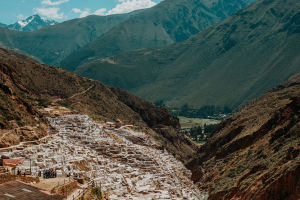Discover Cusco's Treasures
Cusco, once the vibrant center of a remarkable Andean civilization, sits majestically at 3,400 meters above sea level in the Andes mountain range.
Known as the "Navel of the World," this city offers a unique blend of ancient history and modern vibrancy, making it a living museum that continues to captivate visitors.
For all Lykkers eager to explore a place where architecture, culture, and natural beauty meet, Cusco stands as a must-visit destination in South America.
Historical Roots and Cultural Significance
Foundation and Spiritual Importance
Legend holds that Cusco was established around the 12th century by two figures emerging from Lake Titicaca, destined to lead the Andean peoples into civilization.
It became the cultural heart of a vast empire, where impressive palaces, temples, and plazas reflected both authority and spiritual significance.
Transformation and Preservation
In the 16th century, the arrival of foreign conquerors brought significant changes, with many original structures replaced or built upon by new architectural styles. Despite this, Cusco preserves its indigenous roots through its traditions, festivals, and the Quechua language spoken by many residents today.
Architectural Marvels and City Layout
Symbolic Urban Design
Cusco's layout was intentionally designed in the shape of a sacred animal representing strength and protection. The central square, Plaza de Armas, served as the city's heart, surrounded by important temples and residences.
The city's waterways and stone streets showcase advanced engineering skills from centuries past.
Stonework Craftsmanship
The buildings were constructed with massive stone blocks fitted so precisely that no mortar was required. This technique provided exceptional durability, especially against seismic activity, and highlights the extraordinary skill of the ancient builders.
Key Places to Visit in Cusco
Plaza de Armas
This bustling square was historically a gathering place for ceremonies and important events. Today, it is lined with cafes, shops, and impressive buildings.
The mix of cobblestone streets and surrounding mountains creates a charming atmosphere that invites visitors to stroll and soak in the surroundings.
Cusco Cathedral
Located right on Plaza de Armas, this grand cathedral blends various architectural styles and houses an impressive collection of art. Eleven richly decorated chapels feature sculptures, paintings, and altars that reflect a blend of local and European influences. Entry is available via ticket purchase at the site.
Exploring the Sacred Sites
Qorikancha – Temple of the Sun
Once a temple richly decorated with gold, Qorikancha was the spiritual center dedicated to the Sun deity. Though much of the original structure was destroyed, its massive stone foundation remains intact.
The temple now shares its site with a convent built on top, creating a fascinating architectural contrast. Visitors can access Qorikancha with a city archaeological ticket called the Boleto Turístico, which covers multiple sites.
Sacsayhuamán Fortress
This impressive fortress lies just outside the city and is known for its enormous stone blocks, some weighing over 100 tons. These stones fit together with extraordinary precision, without any binding material. Believed to have served as a defensive structure and a place for ceremonies, the fortress offers spectacular views of Cusco and the surrounding valley. Access is included with the Boleto Turístico or through guided tours.
Practical Travel Information
Getting to Cusco
Cusco is accessible by plane via Alejandro Velasco Astete International Airport, located just a few kilometers from the city center. Regular flights connect Cusco with several major cities, making it a convenient entry point for travelers.
Public Transportation and Getting Around
Within the city, buses and taxis are common and affordable ways to explore. Walking is also an excellent option, especially in the historic center where many key attractions are located close to one another.
Tickets and Opening Hours
The Boleto Turístico is a tourist ticket granting entry to several important archaeological sites and museums in and around Cusco. It typically costs around 70 Peruvian soles (approximately 18 USD) and is valid for 10 days. Individual entry fees vary for certain attractions like the Cathedral, usually ranging from 10 to 20 soles.
Most sites open from 8:00 AM to 6:00 PM, though times can vary slightly. It is advisable to check specific opening hours in advance, especially during holidays or special events.
Further Travel Tips
Due to Cusco's high altitude, visitors should take time to acclimate and stay hydrated. Joining guided tours can enhance the experience by providing historical context and deeper insight into the city's wonders. Tours are available in several languages and can be booked locally or online.
In Conclusion
Cusco offers a remarkable journey through time, blending majestic ancient structures with vibrant contemporary life. For Lykkers seeking to immerse themselves in rich culture, breathtaking architecture, and stunning landscapes, Cusco is a destination that promises memorable experiences at every corner.
With its accessible transport, well-preserved sites, and welcoming atmosphere, exploring this historic city becomes an inspiring adventure for all.
-
 Salt Pools Of MarasHave You Seen The Stunning Salt Pools Of Maras Yet? Explore Peru's Ancient Natural Wonder!
Salt Pools Of MarasHave You Seen The Stunning Salt Pools Of Maras Yet? Explore Peru's Ancient Natural Wonder! -
 Top Baltimore HotelsThe Ultimate Baltimore Hotel List: Where Luxury Meets Charm and Comfort!
Top Baltimore HotelsThe Ultimate Baltimore Hotel List: Where Luxury Meets Charm and Comfort! -
 Family Travel TipsSmart strategies for traveling with kids—plan fun, stay safe, and keep everyone happy on your next family adventure.
Family Travel TipsSmart strategies for traveling with kids—plan fun, stay safe, and keep everyone happy on your next family adventure.
Contact to : xyjph123@gmail.com
Privacy Agreement
Copyright © boyuanhulian 2020 - 2022. All Right Reserved.
Privacy Agreement
Copyright © boyuanhulian 2020 - 2022. All Right Reserved.